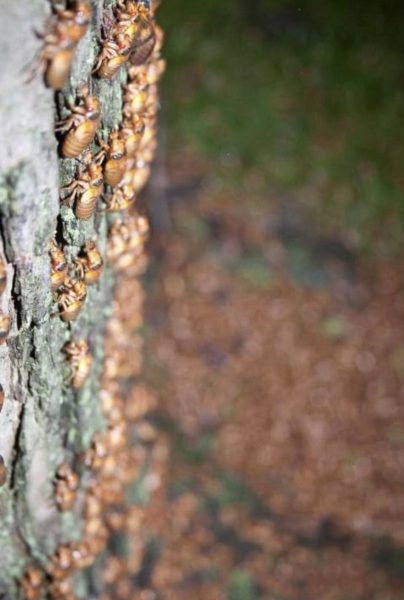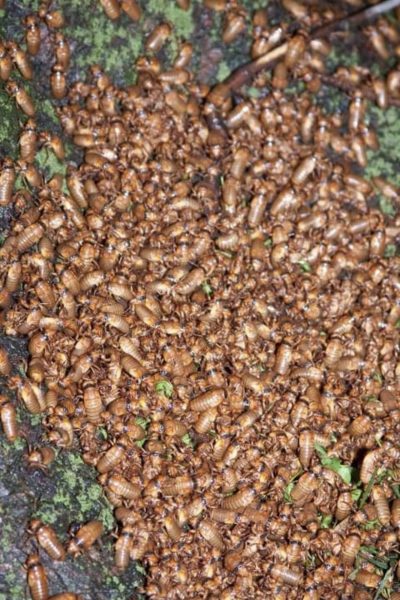
The United States is about to see a special emergence of insects this spring that hasn’t happened since the time of Mozart’s music. But prepare for the volume—the bugs’ noisy call is projected to ring out just as loudly as one of his orchestras for several hours a day.
Sometime between late May and early June, 17 states across the Midwest and Southeast will experience a rare phenomenon called a dual emergence. For the first time since 1803, cicada Broods XIX and XIII will be crawling up from their burrows at the same time. Almost the entirety of Illinois will be home to cicadas this year, said University of Illinois Urbana-Champaign horticulture educator Ken Johnson.
Not everyone in Illinois will encounter the insects, Johnson said. The concentration of cicadas in an area will largely depend on the number of mature trees available.
According to a USDA forest service map from NBC Chicago, Coles County is one of six Illinois counties that will house both broods.
Forested areas will be home to many cicadas, while farm fields will see very few cicadas due to the lack of mature trees for cicadas to munch on as they burrow. Dense urban areas will also see fewer cicadas, Johnson said.
Brood XIII has been underground for 17 years, while Brood XIX has been underground for 13 years. This pattern will prevent the two populations from spending time above the soil together for another 221 years.
A brood of cicadas refers to a geographically based population that emerges at the same time, not a species of cicada. Brood XIII consists of three cicada species and Brood XIX consists of four species, Johnson said.
The insects will begin to appear once the soil hits 64 degrees, Johnson said.
Cicadas spend most of their lives underground as nymphs feeding on tree roots then rise after a number of years. The nymphs crawl up the trees they have spent their time underground feeding on and then molt, leaving a crunchy exoskeleton behind.
Once the nymphs emerge as cicadas, the males call out to the females to begin the mating process, another U of I horticulture educator Christopher Enroth said. Soon afterwards, the females sing back.
After mating, the females find branches on trees about the size of a pinky or less and cut them open with their ovipositor, a sharp organ that several female insects use to deposit eggs, Enroth said. The females will lay their eggs in the slits they create.
The insects will begin to die after four to six weeks. As the remaining nymphs hatch, they drop to the ground and burrow to start the cycle over again, Enroth said.
There are several points in the life cycle of cicadas that can cause issues for affected areas while they are above ground.
As the cicada males attempt to attract mates, they produce a loud sound described to resemble screeching by many. The noise is projected to reach anywhere between 90 and 100 decibels, Enroth said. This could sound like a lawnmower constantly going off, Johnson said.
“When we had a periodical brood emerge a couple years ago, in 2013 or 2014, I remember driving in my car,” Enroth said. “As I was driving my car, I heard this rumble, this high-pitched rumble, and it was the cicada sound. I was coming down the highway too, so you have road noise and all of that stuff, and I still heard that coming through closed windows and everything.”
The sound could become overwhelming for those that work outside. People who could be exposed to the sound for a long time may want to consider buying a pair of earplugs, Johnson said.
While the noise will eventually die along with the cicadas, there are other habits of the insects that may cause more permanent damage.
As the females use branches to hold their eggs, they will cause flagging in trees, an event where certain branches of trees turn brown and die, Enroth said. While mature trees will be able to recover from the flagging and regrow their branches, younger trees could be killed entirely, Johnson explained.
Commercial orchard growers and people who have planted trees within the past two years are at risk of being more seriously affected by cicada-induced flagging, Enroth said.
There is a way to prevent younger trees from suffering during cicada season. If trees are wrapped in a fine-mesh netting and secured firmly at the base, the insects won’t be able to break through the cloth and injure the tree, Enroth said.
There is one con of the dual emergence that will have no solution. When as many as a trillion cicadas begin to die, they will emit a noticeable decaying smell.

Overall, there shouldn’t be any life-changing negative events accompanying the insects, Johnson said.
“It’s not going to be the end of the world,” he said. “This has been happening for thousands of years and everything has been fine.”
In fact, there are a variety of benefits that the dual emergence will induce.
When the insects emerge, they naturally aerate the soil by leaving thumb-sized holes behind them, Enroth said. When the cicadas die, they return nutrients to the ground and feed plants, Johnson said.
Plants are not the only organisms that will benefit from the increase of cicadas. There are several animals that use cicadas as a food source.
Insect-eating birds like turkeys, chickens, cardinals and robins along with mammals like foxes, coyotes and mice will feed on the insects. Even the year before they emerge, moles feed on the growing nymphs.
This is why ecologists believe cicadas burrow underground and come out all at once, Enroth said. Their goal is to overwhelm the system so they can’t possibly all be eaten by predators before they have time to reproduce.
“Everything is going to have a feast come May and June this year,” Enroth said.
Cicadas are such a rich source of nutrients that we may see other insects that feed on cicadas emerging this spring as well.
One of these predators will be a wasp called the cicada killer, Enroth said.
Cicada killers usually emerge in small numbers at the end of each spring to feed on annual cicadas called dog-day cicadas.
Female cicada killers, for example, paralyze cicadas, drag the bodies back to their burrows and lay eggs in the still-living cicada so the hatching cicada killers will have something to feed on, according to a Purdue University report.
Cicadas may be large, but the cicada killers will be larger. However, Enroth said not to worry about being stung by these wasps when they arrive at the end of the season to clean up any remaining cicadas. They have no interest in disturbing humans, he said.
The males, which are the wasps you will typically encounter flying around and looking for mates, don’t even have stingers.
“Nature was very smart when it designed them like this,” Enroth said.
The females will rarely be encountered, since they spend their time searching for cicadas and laying eggs underground, marking humans safe from being stung.
Animals aren’t the only ones who eat cicadas.
“Humans could eat them, if you really wanted to. Personally, that’s something I’m looking forward to—getting to try it,” Johnson said.
Evidence shows that Native American tribes used to use cicadas as a prominent food source, Enroth said. They have been reported to taste like almonds with a crunchy outside and gooey center. There are some cookbooks isolated to recipes concerning preparing cicadas.
Overall, experts believe this will be a year to remember.
“I would say to everyone to just try and enjoy what’s about to happen, because no one is going to see this for the next couple generations,” Enroth said. “Experience something weird that nature does. It’s pretty neat.”
Olivia Bennett can be reached at 581-2812 or at ojbennett@eiu.edu.

















![[Thumbnail Edition] Senior Foward Macy McGlone, getsw the ball and gets the point during the first half of the game aginst Western Illinois University,, Eastern Illinois University Lost to Western Illinois University Thursday March 6 20205, 78-75 EIU lost making it the end of their season](https://www.dailyeasternnews.com/wp-content/uploads/2025/03/WBB_OVC_03_O-1-e1743361637111-1200x614.jpg)


















































![[Thumbnail] Eastern's Old Main was quiet Thursday morning while educators who had left the office to strike picketed outside.](https://www.dailyeasternnews.com/wp-content/uploads/2025/04/Strike_01_LT_O-800x1200.jpg)



